
Brand Architecture
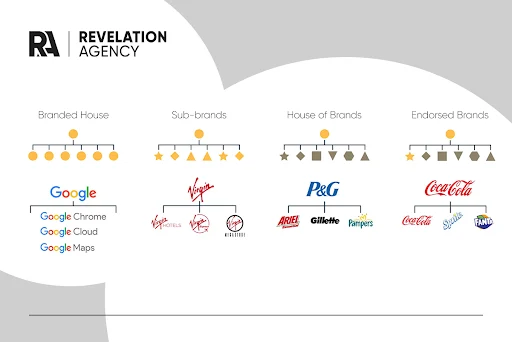
In this post, we dive into the four primary forms of brand architecture. Understanding the distinctions between how brands can be structured within a business is helpful if you start from scratch or need to consider a Brand Refresh.
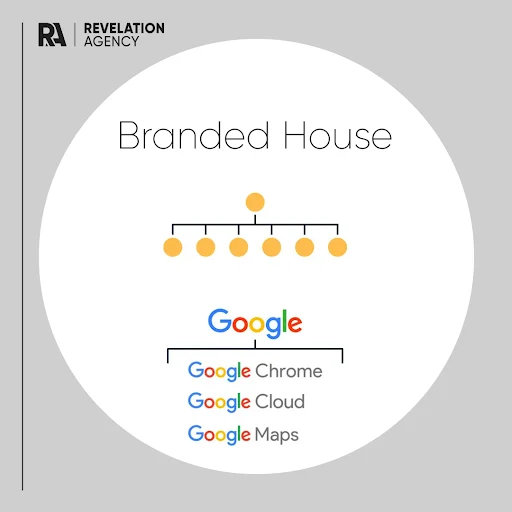
Branded house
The branded house architecture in branding refers to a strategy where a parent company applies its brand name to a range of products or services. All products or services share the same values, visual identity, and messaging, creating a unified brand image.
For instance, Google is a classic example of a branded house. All its services, like Google Maps, Google Drive, or Google Search, are closely linked to the leading Google brand. They share the same visual style, values, and overall brand message, ensuring that customers associate all these services directly with Google.
This strategy contrasts with a “house of brands,” where a parent company owns multiple brands that operate independently, each with its unique identity and market position. Procter & Gamble is an example of this, with distinct brands like Tide, Pampers, and Gillette under its umbrella.
In the case of Google and other branded house examples, the overarching brand’s reputation can significantly impact all its products and services. This approach helps build brand equity but also means that any negative publicity affecting the parent brand can impact all its sub-brands.
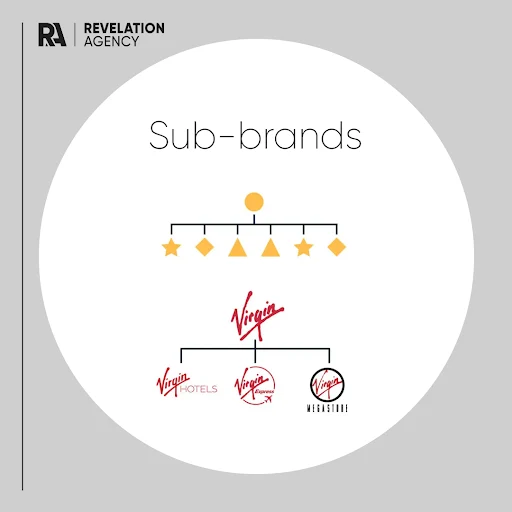
Sub-brands
Sub-brands operate under the umbrella of a parent brand but maintain a degree of independence, distinguishing themselves through unique features, styles, or attributes. While they align with the overarching values and message of the parent brand, sub-brands have distinct product or service lines and often target specific market segments or needs.
For example, Apple and Virgin illustrate this approach effectively. While a cohesive brand, Apple has sub-brands like the iPhone, iPad, and Mac. Each product carries the Apple brand’s reputation for innovation and quality but is designed to meet different consumer needs and preferences. The iPhone focuses on mobile communication and multimedia, the iPad targets portable computing and entertainment, and the Mac serves a more traditional computing role. Despite their differences, all these products are visually and thematically aligned with the Apple brand.
Similarly, Virgin operates various businesses under sub-brands like Virgin Atlantic, Virgin Mobile, and Virgin Galactic. Each caters to different sectors (aviation, telecommunications, and space travel, respectively) but shares Virgin’s core values and brand identity – innovative, adventurous, and customer-focused. The visual presence of the Virgin brand is evident in all these sub-brands, reinforcing the connection to the parent brand while allowing each sub-brand to develop its unique market position. brand.
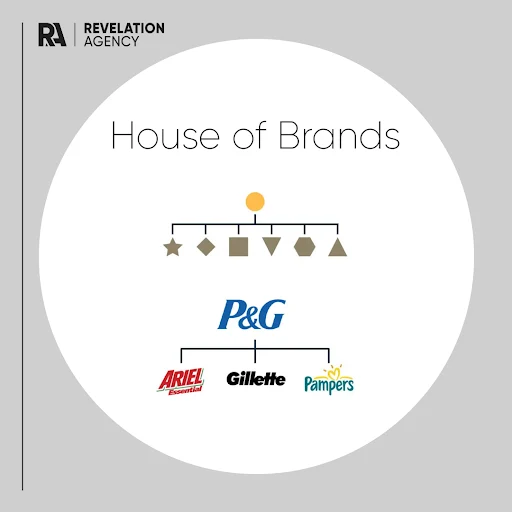
House of brands
In the House of Brands, a parent company owns multiple subsidiary brands, each operating as a separate entity with its own identity, including distinct logos, names, slogans, and marketing strategies. These sub-brands are often so distinct that consumers may need to be aware of their connection to the parent company. This architecture allows for targeting different market segments and customer needs without overlapping or diluting the individual brand identities.
Procter & Gamble (P&G) is a classic example of this approach. P&G owns various brands across consumer segments, such as Tide in laundry detergents, Pampers in baby care, and Gillette in personal grooming. Each of these brands operates independently, focusing on its specific market niche. The connection to P&G is primarily for administrative, strategic, and investment purposes, and it’s not prominently advertised or necessarily known to the average consumer.
This strategy allows for diversification and minimizes the risk to the parent company if one of the brands faces a challenge. It also enables each brand to develop its unique personality and market positioning, tailored to its specific audience, without being constrained by the parent brand’s identity or reputation.
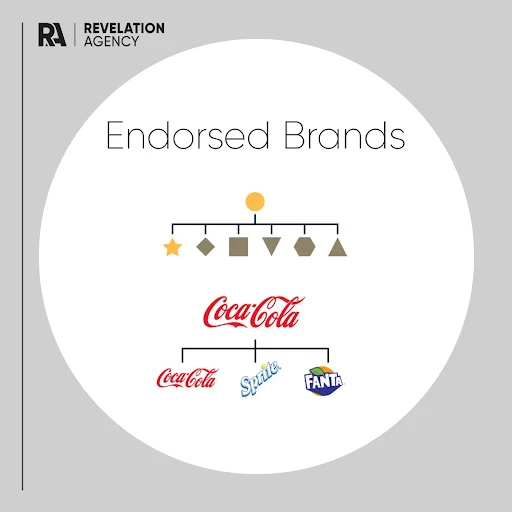
Endorsed or hybrid brands
The endorsed brand architecture, also known as a blended house or hybrid brand, is a strategic approach that combines elements of the branded house and house of brands models. In this architecture, sub-brands maintain their unique brand promise and identity, yet they also leverage certain features and elements of the parent brand. This approach balances each sub-brand’s distinctiveness and the parent brand’s overarching strength.
Under the endorsed brand architecture, the parent brand owns the sub-brands, but these sub-brands enjoy a significant degree of individuality and flexibility. This allows them to have a distinct presence in the market, appealing to different customer segments with specific brand promises. While they benefit from the parent brand’s reputation, image, and heritage, they are not tightly controlled or dictated by the parent brand in their actions. However, there’s an expectation for these sub-brands to uphold a certain level of performance and quality consistent with the parent brand’s values.
This structure is often in companies that have grown through mergers and acquisitions, allowing newly acquired brands to retain their identity while benefiting from the association with a more prominent, established parent brand.
Marriott and Coca-Cola are notable examples of this approach. Marriott, for example, has several sub-brands like Ritz-Carlton, Courtyard, and Residence Inn, each catering to different segments of the hospitality market while being part of the more prominent Marriott family. Similarly, Coca-Cola owns various beverage brands like Sprite, Fanta, and Dasani, each with its unique market position and brand promise. Yet, all benefit from the global recognition and trust of the Coca-Cola brand.
Brand architecture is fundamentally about the way a brand communicates with its consumers. The key to effective brand architecture lies in its simplicity and structure. A clear and structured hierarchy in brand architecture is crucial because it aids in making the brand’s offerings and identity more understandable to customers.
The importance of brand architecture should be considered during the initial stages of brand creation. Many businesses focus on it only after their products are established in the market. This oversight can lead to confusion among consumers and inefficiencies in brand management. As a result, rebranding is necessary to streamline the brand’s offerings into a more coherent and logical structure. This reorganization benefits internal business processes by providing more straightforward guidance on brand strategy and product development and enhancing customer relationships by making the brand’s portfolio more navigable and understandable.
Brand architecture is fundamentally about the way a brand communicates with its consumers. The key to effective brand architecture lies in its simplicity and structure. A clear and structured hierarchy in brand architecture is crucial because it aids in making the brand’s offerings and identity more understandable to customers.
Author | Tyler Vaughn




